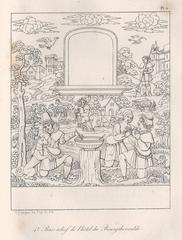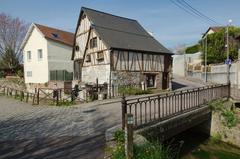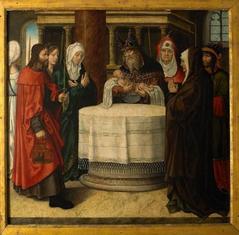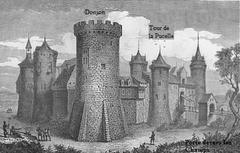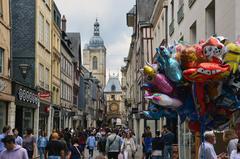Avenue Champlain Rouen France: Visiting Hours, Tickets, and Historical Sites Guide
Date: 04/07/2025
Introduction: Explore Avenue Champlain in Rouen
Avenue Champlain in Rouen, France, is both a symbolic tribute to the explorer Samuel de Champlain and a vibrant urban artery connecting visitors to the heart of Normandy’s capital. Set near the Seine River, this avenue links the city’s medieval legacy with its contemporary vitality. From its Roman roots and postwar transformation to its role in local festivals and daily life, Avenue Champlain stands as a testament to Rouen’s enduring spirit.
This guide delivers in-depth insights on Avenue Champlain’s origins, historical evolution, practical visitor information, nearby attractions, transportation options, and expert travel tips. Whether you are a history enthusiast, architecture lover, or cultural explorer, you’ll find all the details needed for a seamless and enriching visit, including up-to-date visiting hours, ticketing, and accessibility.
For official tourism resources, see Rouen Official Tourism and further reading at Normandie Lovers.
Table of Contents
- Introduction
- Origins and Naming of Avenue Champlain
- Location and Urban Context
- Historical Evolution
- Cultural and Historical Significance
- Visitor Information
- Nearby Attractions and Historical Sites
- Transportation and Access
- Festivals and Community Events
- Practical Tips
- FAQ
- Conclusion & Recommendations
- References
Origins and Naming of Avenue Champlain
Avenue Champlain is named after Samuel de Champlain, the renowned French explorer and founder of Quebec City, who was born near Rouen. The avenue embodies Rouen’s maritime and exploratory heritage, linking local history with global impact (Wikipedia; wikimonde.com).
Location and Urban Context
Strategically located on Rouen’s right bank, Avenue Champlain connects rue Lafayette, place Carnot, and pont Pierre-Corneille, with the Seine River nearby. Its alignment facilitates access between Rouen’s city center, historic quarters, and riverfront, making it a convenient starting point for visitors (Explorial; About-France).
Historical Evolution
Roman and Medieval Foundations
Rouen, originally Rotomagus, was a prominent Roman settlement and later the capital of the Duchy of Normandy. Avenue Champlain’s area reflects the city’s historical expansion and importance as a trade and cultural hub along the Seine (About-France; Visiterouen).
Modern Development
The avenue assumed its current form during the post-World War II reconstruction, integrating modern urban planning with heritage conservation. This blend of tradition and progress is visible in the avenue’s architecture and layout (Wikipedia; frenchmoments.eu).
Cultural and Historical Significance
Avenue Champlain stands as a tribute to Samuel de Champlain and Rouen’s maritime legacy. The avenue’s proximity to the Seine and local institutions, such as the Mission Locale de l’Agglomération Rouennaise, highlights its role in community life and youth engagement (Gralon).
Visitor Information
Visiting Hours
- Avenue Champlain: Open and accessible 24/7 as a public street.
- Nearby Attractions: Key sites such as Rouen Cathedral and the Gros-Horloge typically open from 8:00 or 9:00 AM to 6:00 or 6:30 PM. Confirm hours on official websites or at the Rouen Official Tourism center.
Tickets and Passes
- Avenue Champlain: No entry fee.
- Historical Sites: Most museums and attractions require tickets (€5–€10 standard). Consider the Rouen Pass for savings on multiple sites, public transport, and tours.
Accessibility
- Public Transport: Multiple bus (lines 27, F1, F4, F7, etc.) and tram lines (T1, T2, T3) serve the avenue. The “République - Quais” stop is a 2-minute walk (Moovit).
- Parking: Limited on-street parking; recommended lots include the Cathedral parking area (Normandie Lovers).
- Mobility: The avenue and most major attractions are accessible for visitors with reduced mobility.
Guided Tours
Guided walking tours, audio tours (via the Audiala app), and the Petit Train de Rouen offer historical insights and convenient sightseeing. Booking in advance, especially during festivals, is recommended.
Photographic Spots
Scenic points along the Seine, near pont Pierre-Corneille, and the historic core (Gros-Horloge, Place du Vieux-Marché) are ideal for photography.
Nearby Attractions and Historical Sites
- Cathédrale Notre-Dame de Rouen: Gothic masterpiece, open daily, free entry; guided tours on weekends (The Good Life France).
- Le Gros-Horloge: 14th-century astronomical clock; tower museum open Tues–Sun, 10:00 AM–5:00 PM, €7.50 entry (Forever Lost in Travel).
- Place du Vieux-Marché & Église Sainte-Jeanne-d’Arc: Site of Joan of Arc’s martyrdom; church open 9:00 AM–6:00 PM (Les Trois Fenêtres).
- Musée des Beaux-Arts de Rouen: Art museum with free entry to permanent collections; open Tues–Sun, 10:00 AM–6:00 PM.
- Abbatiale Saint-Ouen: Gothic abbey, open daily, free access.
- Aître Saint-Maclou: Medieval ossuary with artisan workshops, open 10:00 AM–6:00 PM.
Find more on Normandie Lovers and Rouen Official Tourism.
Transportation and Access
- Public Transport: Extensive bus and tram networks, including night service (NOCTAMBUS). Use the Moovit app for real-time schedules.
- Cycling: The Seine à Vélo route offers direct cycling paths along the river (Normandie Tourisme).
- Driving: Parking is limited; use city lots and observe local signage.
Festivals and Community Events
Avenue Champlain is integrated into Rouen’s major events, including:
- Fêtes Médiévales de Rouen: Three-day medieval festival with parades and markets (Vitrines Rouen).
- Armada: Tall ships event held every five years.
- Rouen Impressionnée: Annual Impressionist art festival in June.
Practical Tips
- Best Visiting Times: Spring and early summer for pleasant weather and festivals.
- Weather: Normandy is variable; bring layers and an umbrella.
- Dining: Sample Norman specialties in the city center; try La Couronne for traditional cuisine.
- Markets: Visit Place du Vieux-Marché or Place Saint-Marc for local produce and delicacies.
- Safety: Standard precautions apply; Rouen is generally safe and welcoming.
Frequently Asked Questions (FAQ)
Q: Is Avenue Champlain open to visitors at all times?
A: Yes, it is a public street accessible 24/7.
Q: Do I need tickets to visit historical sites nearby?
A: Most museums and attractions require tickets; some churches offer free entry.
Q: Is Avenue Champlain accessible via public transport?
A: Yes, multiple bus and tram lines serve the area.
Q: Are there guided tours of the area?
A: Yes, including walking tours and audio guides.
Q: What is the best way to plan my visit?
A: Use the Moovit app for transport and the Rouen Pass for attractions.
Conclusion & Recommendations
Avenue Champlain offers a unique vantage point for immersing yourself in Rouen’s historic grandeur and lively present. Its strategic location, rich heritage, and seamless access to key attractions make it an essential stop on any Normandy itinerary. For a rewarding experience, plan ahead using visitor resources, consider guided tours, and embrace the city’s festivals and gastronomy.
For further planning, visit Rouen Official Tourism and Normandie Lovers, and download the Audiala app for curated tours and real-time updates.
References
- Avenue Champlain in Rouen: History, Visiting Tips, and Nearby Attractions
- Discover Avenue Champlain in Rouen: A Guide to Visiting Hours, Tickets, and Nearby Historical Sites
- Exploring Avenue Champlain and Nearby Historical Sites in Rouen: Visiting Hours, Tickets, and Travel Tips
- Practical Visitor Information and Recommendations
- Official Rouen Tourism
- Normandie Lovers
- Vitrines Rouen
- The Good Life France
- Forever Lost in Travel
- Les Trois Fenêtres
